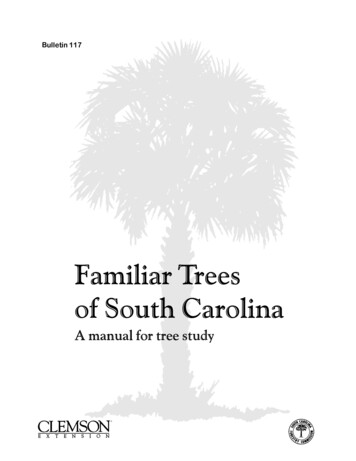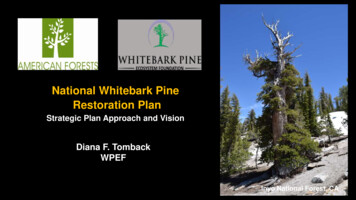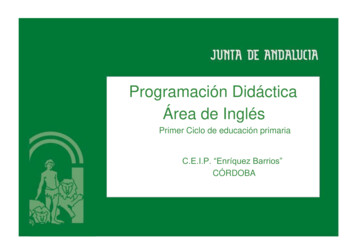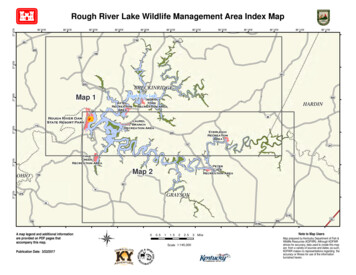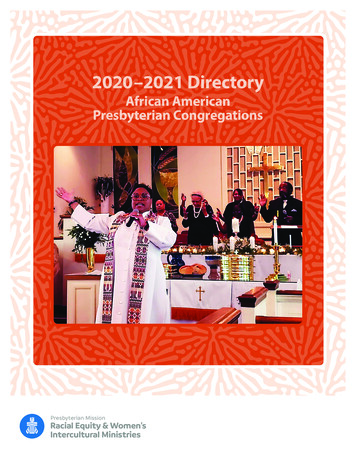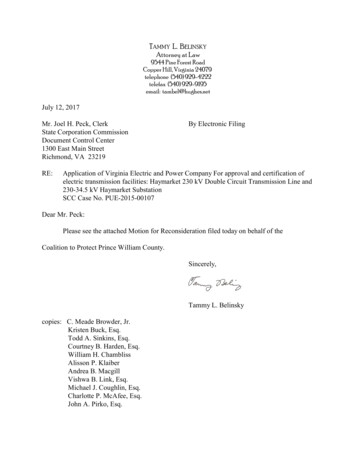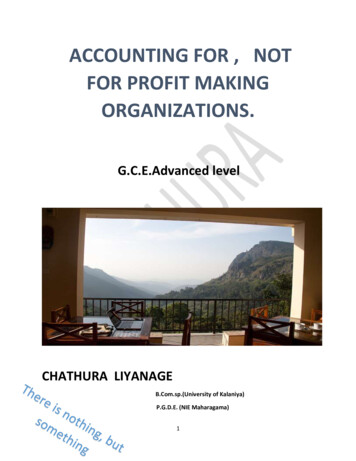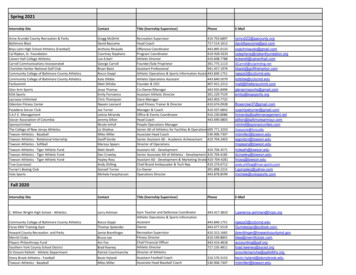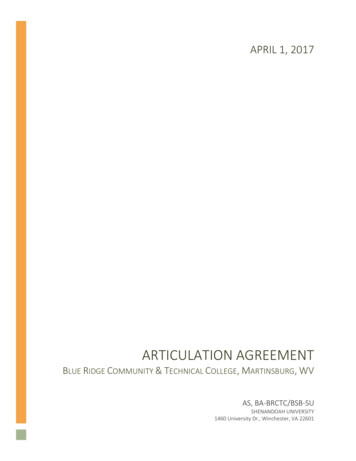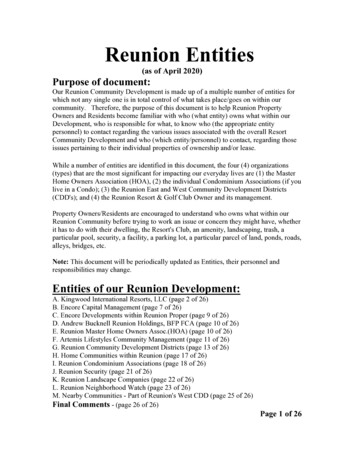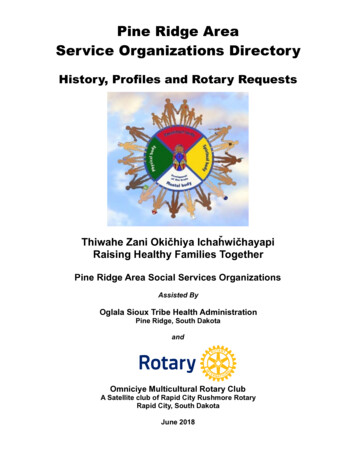
Transcription
Pine Ridge AreaService Organizations DirectoryHistory, Profiles and Rotary RequestsThiwahe Zani Okičhiya IchaȟwičhayapiRaising Healthy Families TogetherPine Ridge Area Social Services OrganizationsAssisted ByOglala Sioux Tribe Health AdministrationPine Ridge, South DakotaandOmniciye Multicultural Rotary ClubA Satellite club of Rapid City Rushmore RotaryRapid City, South DakotaJune 2018
!Thiwahe Zani Okičhiya IchaȟwičhayapiRaising Healthy Families Together is an informal network of social service organizationsproviding services to the residents of the Oglala Lakota Nation on the Pine Ridge IndianReservation in South Dakota.It was founded in 2015. It has an email base of 40 members. It meets four times a year toshare information between members. A member organization gives a presentation of his/herorganization and every participant provides an update of any staff changes and what theirorganization is doing. There is also a shared calendar for the next three months of eventsengaging social service agencies.This Pine Ridge Area Social Services Organizations Rotary Directory wasoriginated by Angie Sam, TANF Director. Her intern, Maretta Afraid of Bear, collected the initialdata and Robyn Whirlwind Horse assisted with data entry in 2016/17. Dr. Craig Howe, Center forAmerican Indian Research and Native Studies (CAIRNS) and Tom Allen, Oglala LakotaCollege, provided historical and contemporary Tribal information. On behalf of Omniciye MultiCultural Rotary Club; Bev Warne, Kibbe Conti, Gloria Eastman and Tom Katus were membersof the initial visiting team. Terri Hunter wrote the chapter on Lakota History, Dee Katus editedthe data, Tom Katus, provided over all management to the project, and Linda Petersonprovided final editing and electronic publishing.If you would like to be added to Raising Healthy Families Together email group toreceive notification of future meetings and other activities, please contact:Carrie Churchill, RNBright Start Home Visiting Program ManagerSouth Dakota Department of Health909 E. St. Patrick St, Suite 7Rapid City, SD 57701carrie.churchill@state.sd.usOffice: 605-394-2495 Cell: 605-391-5036 Fax: 605394-1929!2
TABLE OF CONTENTSThiwahe Zani Okičhiya Ichaȟwičhayapi—Raising Healthy Families Together2Acknowledgements4What is Rotary and how do we use this Directory to connect?5Omniciye Multi-cultural Rotary Club6History of the Oceti Sakowin, Lakota People and the Oglala Sioux Tribe7Oglala Sioux Tribe Today16Summary Historical Overview16Demographics16Geographic Area16Oglala Sioux Tribe Government Today18Profiles of Pine Ridge Area service organizations19Cross-reference of projects by Rotary priority areasPeace & Conflict Resolution/PreventionDisease Prevention & TreatmentWater & SanitationMaternal & Child HealthBasic Education and LiteracyEconomic & Community Development33Contributors35!3
AcknowledgementsOn behalf of the Oglala Sioux Tribe Health Administration, I would like to thank the ThiwaheZani Okičhiya Ichaȟwičhayapi—Raising Healthy Families Together network for their initialresearch in developing this Directory. I would especially like to thank Angie Sam, TANFCoordinator and her assistants, Maretta Afraid of Bear and Robyn Whirlwind Horse whocompleted initial research and data entry for the Directory.Dr. Craig Howe, Center for American Indian Research and Native Studies (CAIRNS)was the lead cooperating organization to Omniciye and provided continuous professionalproject overview and critiquing, especially of the Lakota History chapter. Tom Allen, OglalaLakota College, provided contemporary Tribal information.I would additionally like to thank the Omniciye Multicultural Rotary Club members: BevWarne, Kibbe Conti, Gloria Eastman, and Tom Katus, who launched the Project with their initialvisit to Pine Ridge. Terri Hunter, Dr. Dee Katus, Tom Katus and Linda Peterson providedextensive writing, editing and publishing of this Directory.This Directory also represents a major goal of the Pine Ridge Children's TelehealthServices Network, administered by OST Health Administration.I do hope this Pine Ridge Area Services Rotary Requests Directory will be helpful to allcommunity members and, especially, the participating human and social services providers, aswell as Rotary clubs from District 5610 and beyond.Pilamiya,Delores Pourier, MSASOST Health AdministratorJune, 2018!4
What is Rotary and how do we use this Directory to connect?There are 35,000 Rotary clubs throughout the world that are members of RotaryInternational. There are 41 Rotary clubs in District 5610, in South Dakota, western Minnesota,NE Nebraska and NW Iowa.This Directory was developed by Raising Healthy Families Together, assisted by theOmniciye Multi-cultural Rotary Club, a satellite of Rapid City Rushmore Rotary Club, RapidCity, South Dakota. The Omniciye Club asked the members of RHFT to expand or composetheir organizational profiles, assess the communities they serve, and outline potential projectsRotary clubs might wish to consider for support of volunteers, materials and funds.Rotary clubs from District 5610 and other Districts throughout the USA and globally canreview the Directory organizational profiles and project requests and contact Pine Ridge areaprojects directly. Pine Ridge area service organizations can likewise directly approach Rotaryclubs to support them.For example, two Rotary clubs from Vermont and New Hampshire have been providingsupport to grassroots projects on Pine Ridge for over five years. After reviewing a draft of thisDirectory, a Rotary District in Australia is proposing an exchange program engaging aboriginalAustralians and Native Americans.At the local level, Omniciye Multi-Cultural Rotary Club and other District 5610 Clubsmay choose to provide volunteer, material and limited funding support. (see next page profileof projects Omniciye has supported over the past four years). At the Rotary District level,grants of between 2,000-5,000 annually can be requested. An organization would needsupport of at least one local Rotary club. Global grants from the Rotary Foundation start at 30,000. A project would need to qualify for a District grant before requesting the much largerglobal grant.Browse the District 5610 website for more information about clubs atwww.Rotary5610.orgBrowse the Rotary International website at www.Rotary.org!5
Omniciye Multi-Cultural Rotary ClubThe Omniciye Multicultural Rotary Club, was established in 2014 as a satellite club ofRapid City Rushmore Rotary. Once it attains a membership of 20, it will be able to berecognized as a fully-fledged club. It is currently a Committee of the Rushmore Club, one of 41such clubs in District 5610 (South Dakota, Western Minnesota, NE Nebraska and NW Iowa).Rotary, with the motto “Service Above Self”, is the largest service organization in theworld, with 1.2 million members in over 35,000 Rotary Clubs. The Omniciye Club is unique inits multi-cultural membership and Native American leadership. It was purposely formed toassist Native American and other multi-cultural professionals to provide voluntary support andfunding for local and international multi-cultural projects. While only four years old, it hassupported the following local and international projects: Planted and maintained a traditional “Three Sisters” Native American garden at OglalaLakota CollegeRenovated bicycles for free distribution to Native American and other youth in RapidCityProvided scholarships for Native American middle school students to participate inIndian Youth of America summer camp in the Black HillsRepaired barriers and placed “No Trespassing” signs to protect traditional grave sites onthe original Sioux San grounds near West Middle SchoolOrganized a series of community meetings focusing on how education, media, andbusinesses can be improved to expand multi-cultural diversityCo-sponsored with Rushmore Rotary, Reception for Native Artists, at the Great RaceExhibit sponsored by the Center for American Indian Research and Native Studies(CAIRNS)Home-hosted international visitors from Australia, Latin America, Russia and theUkraine.Built Little Free Library, community free book exchange cabinet for North Rapid CitycommunityCoordinated 4 Way essay writing competition for North Middle School studentsReceived Rotary District 5610 Grant to assist Native organizations in youth assessmentand development on the Pine Ridge Indian Reservation The Club was founded by a small group of Native American and other multi-culturalprofessionals in Rapid City. Founding members included: Kibbe Conti, Sheela Farmer andGayla Bennett, all past Presidents, Karen Psiaki, past Treasurer; Edmund Banley; GloriaEastman; Tom Katus; Tim and Paula Pederson; Laurette Pourier and Gene Tyon. Newermembers are Colby Christensen; Linda Peterson, Terri Hunter, and Beverly Warne, President.Kibbe Conti, Treasurer.See the Rapid City Rushmore Rotary Club website for contacts at www.RushmoreRotary.org!6
History of the Oceti Sakowin, Lakota People and the Oglala SiouxTribeby Terri Hunter with guidance from Dr. Craig HoweOne of the biggest challenges the Lakota people have faced since they settled in thereservations is the battle to define themselves instead of being defined by Euro-Americandominant culture, whose words are often deceptively couched in tones of scientific objectivityand/or Christian charity. This dominant culture, in an effort to “rescue” Lakotas from a “stoneage” existence and improve their lives by assimilating them into the modern “civilized” world,forcibly repressed language, oral history, spiritual belief and practices, and social mores. Theaftermath of these policies, whether the result of well-meant intentions or an agenda of greed,has left in its wake a once rich people often struggling in poverty conditions that rival those ofthird-world countries, while the descendants of Euro-American settlers have prospered fromthe riches of what was once Lakota lands. This is the legacy of colonialism for theseindigenous people.The Oglala Lakotas, of which this project is concerned, live in Pine Ridge IndianReservation. Having resisted assimilation while still adopting dominant culture technology,Oglalas have kept their culture intact, miraculously perhaps, and many Oglalas are working toovercome what has been the crippling effect of these “civilizing” government policies, byreviving the Lakota language and many traditional spiritual and social practices. A part of anycultural identity is its history, and Oglalas’ prehistory and history is often complicated by thedichotomy of how they understand their origins versus how many professional representativesof dominant society have characterized them in writing. Beyond just being problematic in termscultural identity, the dominant narratives have been used to justify the land grabs and otherinjustices in the psyches of the descendant settler classes. At the crux of this controversy areLakota traditional beliefs about the Black Hills and the history behind the modern configurationof the reservations.Sometimes called the Paha Sapa (Black Hills) and sometimes referred to as He Sapa(Black Mountains) in Lakota, the US Government officially took the Black Hills in the 1877Manypenny Act, the first confiscation of land after the 1868 Fort Laramie Treaty—and it was aconfiscation. The commission did not even try to get three-fourths of the male Lakotas’signatures. It simply threatened those who were trying to stay in the reservations with awithholding of rations and annuities, which amounted to starvation, and proceeded to waragainst those who refused to live in the reservations (Welch, 196-7).For Lakotas, the Black Hills are sacred with many narratives tied to physical formationsin the land. But often in the ethnological and later anthropological literature, “experts” arguesuch points as that the Lakota were afraid of the spirits in the Black Hills, only entered theBlack Hills to harvest tipi poles, (Sundstrom, 185-6) and only thought of it as a cache of sortsfrom which they could glean sustenance: “Lakotas most esteemed the Paha Sapa (literally,“hills that are black”) not for their mystic aura, as is commonly assumed, but for their materialbounty. The hills were their meat locker, a game reserve to be tapped in times ofhunger” (Cozzens). Early ethnologists such as James Mooney even tried to argue that theorigins of the Lakotas and their confederates were in the Eastern United States by using socalled linguistic evidence (Mooney, 9). The idea that the development of a people can betraced linguistically through historical linguistics is controversial and many linguists have sincerelegated it to bunk science, but the concept persists among dominant culture members inWestern South Dakota and often, although unconsciously, shapes interactions between thetwo.!7
Lakotas have different narratives about their beliefs and origins. Often the criticism isthat many of these beliefs have a modern origin in the revitalization period of the 1970’s;however, the language barrier, the repression of Indian religious practices, and the forcedassimilation policies could very well be reasons why these narrative traditions were not wellknown in dominant society. (It was not until the August 11, 1978 American Indian ReligiousFreedom Act that Indians were able to openly practice their spiritual beliefs again.) Oraltradition narratives place Lakota ancestors in and around the Black Hills. Some traditionsname the cave as Wasun Niya, (breathing hole) more commonly known today as Wind Cave,located in the southern Black Hills region, although the age of this tradition is unknown(Sundstrom, 197). Lakota historian James LaPointe does identify Wind Cave as a point oforigin of the buffalo and other animals, and says that medicine men traveled for thousands ofyears to worship at the site (80). Another tradition recorded in the Sundance and otherCeremonies of the Oglala Division of Teton Sioux, by Dr. James R Walker, a white physicianliving and working in the Pine Ridge Reservation from 1896 to 1914, describes Lakotaancestors emerging onto the surface of this world from a cave and traveling to a place in thepines (Walker, 182). This is only one of several sites in and around the Black Hills tied toLakota narratives.Another physical formation, Ki Inyanka Ocanku, often glossed as “The Race Track” is alarge band of red clay soil that encircles the Black Hills. A narrative about a Great Race tells ofall the animals called together to establish “peace and order” (LaPointe, 18), or perhaps betterdescribed as precedence and protocol, social mores valuable in Lakota tradition, in the world.The animals raced around guideposts for 100 days and in the end a giant volcano erupted,burying the animals and creating the upheaval of the Black Hills. One of these racing animalsincluded in the narrative is the Unkche Ghila, which Lakota historian James LaPointe says is a,“huge animal whom no human being in modern times has ever seen alive,” and whose, “hugebones can be found in the badlands to the east of the Black Hills” (19). Beyond thisexplanation, there is no way to know exactly to which animal or animals the narrative isreferring, but the Black Hills, Badlands and surrounding areas have long been known as aMecca for fossil hunters. (Indeed, one of the largest and most fully intact—and controversial-Tyrannosaurus Rex ever found was north of the Black Hills in the Cheyenne RiverReservation.) Drivers moving south on US Highway 16 by the tourist destination ReptileGardens can easily spot the red clay earth from the highway. While there is no way to placeany of this within the scope of modern linear time as understood in dominant culture scientificphilosophy, this oral tradition narrative argues for an ancient origin of the Lakotas.A laccolith sits on the northeastern edge of the Black Hills called Bear Butte, or MatoPaha, one place of traditional hanbleciya, or vision quest, and is held sacred by several Indiannations in addition to the Lakotas. The Sturgis Motorcycle Rally, an August gathering that hasbecome a 78-plus year tradition, has reached the point where the week-long event drawsmotorcycle enthusiasts from around the world and swells the population of an otherwise sleepylittle town of around 10,000 to more than a quarter of a million people, equivalent to anincrease of a quarter to a third of the state’s overall population. A fifty-acre campground andsaloon, The Full Throttle, boasting the distinction of being “the world’s largest biker bar,” sitsjust to the north on Highway 79 near the base of this place of prayer despite Lakota objectionsto the disrespectful proximity of alcohol consumption and adult entertainment.Many such sacred sites are fraught with controversy between traditional Lakotas andthe non-indigenous and even mixed-blood population. Several sites are tied to the culturaldemigod Wicapi Hinpaya, or Fallen Star. One of these narrative involves Mato Tipila (BearLodge), known as Devil’s Tower. One of many narratives attached to Mato Tipila is that sevenlittle girls were away from their wicoti, camp, playing, when they were threatened by bears. Thegirls could not outrun the bears, so they stood on a small rise and prayed for deliverance. Taku!8
Wakan, the sacred mystery, raised the ground up high enough that the bears could not reachthem, and the striations in its sides are the markings of the bears’ claws as they continuallytried to climb up and slid back to the ground. Molton rocks then crashed down the sides andburied the bears. Wicapi Hinpaya ascended from the cloud world and had them carried backoff the mountain by a covey of birds to their families (Lapointe, 67). Near Mato Tipila is InyanKaga, Stone Maker, where oral tradition says Lakota would gather stones for the inipi orsweatlodge, (Sundstrom, 190) a purification ceremony performed previously but notexclusively to the sundance. While it is a national historical landmark, it is surrounded byprivate land and permission must be obtained from the landowner to visit it.Devil’s Tower is also a popular tourist destination and climbing spot. In 1995, theNational Park System worked out a climbing use plan involving Native Americans andrepresentatives of the climbing industry. It resulted in a voluntary rather than compulsoryclimbing ban, which according to park superintendent Tim Reid was the idea of the NativeAmericans because it was more in keeping with the spirit of showing respect for sacred sites.The ban has been voluntary since 1995, and while the numbers initially fell from 1,200 in 1994to 167 in 1995, they have steadily inched upwards to 373 in June of 2016, and while the datais imperfect, it seems to show that those ignoring the band are local and regional climbers(Mullen).Yet another site recently embroiled in controversy, Hinhan Kagapi, or “Owl-making,”refers to the largest mountain peak east of the Rocky Mountains. Another Lakota narrative tellsof a giant winged beast who lived on the mountain and would swoop down and steal childrenwhen the people were camped nearby. These children were eventually rescued and placedamong the stars by Wicapi Hinpaya. The official designation of Hinhan Kagapi, formerly knownas Harney Peak, for Colonel William Harney, has been changed recently to Black Elk Peak. InBlack Elk Speaks, Black Elk’s vision takes part partially at Hinhan Kagapi. (Sundstrom, 199). Incontrast, Harney’s very name is anathema to Lakotas, after the Blue Water Massacre in 1855in what is now Nebraska. In retaliation for the Mormon Cow Incident, also known as theGrattan Fight or Grattan Massacre, which was unprovoked by the Lakotas and resulted in thedeath of Mato Wayuhi, Chief Conquering Bear, and other incidents, Harney deceitfullyemployed a delay tactic by telling Wakiyan Cikala, Little Thunder, a Sicangu Lakota itancan,that he wanted to parley. While thus engaged with Little Thunder and his warriors, one ofwhom was Sinte Gleska, Spotted Tail, Harney sent a large portion of his 600 troops out tosurround and destroy Little Thunder’s village of approximately 250. By official count, eighty-sixtotal Lakotas were killed and 70 women and children were captured (Mattes). But in the wordsof Lydia Whirlwind Soldier, did they count the dead found in the caves by white settlers a year later, did theycount the two little girls clinging together in the water two miles from the original campsite, did they count the babies whose mothers tried to protect them with their bodies,and did they count those who were mortally wounded and died from their wounds at alater day. I doubt it.There is no known record of Col. William S. Harney even visiting the highest point inSouth Dakota, yet the name stood for 150 years, with its first known association in 1857 and itsofficial naming in 1906. In 2015, the South Dakota Board on Geological Names originally votedto return to the Lakota name Hinhan Kaga, with the English translation Making of Owls, butreconsidered after over 300 comments of objection. Then, after a letter from Basil Braveheart,Oglala Sioux Tribal Member and Korean War Veteran, the US Board of Geological Namesvoted 12-0 with one abstention to change it in 2016 to Black Elk Peak. Fortunately, the USBoard on Geological Names is empowered by federal policy to change names in cases where,“ a name is shown to be highly offensive or derogatory to a particular ethnic or racialgroup ” (Saum).!9
As mentioned before, the demigod Wicahpi Hinpaya, Fallen Star, in some Oglalatraditions is tied to other sacred sites in addition to Hinhan Kagapi. Pe Sla is a reference to alarge mountain prairie in the heart of the central Black Hills. There are many versions as toWicahpi Hinpiya’s birth, but basically he is the son of a being of the Mahpiya Oyate, or CloudNation, and a Lakota woman, who went to live in the Cloud Nation and then becamedisenchanted and tried to lower herself back to earth. She did not have enough rope, andended up falling back to earth. The impact killed her, but caused her son to be born and hewas adopted into a Lakota tiospaye, or extended family. He developed quickly and returned tohis father’s people, but cares for and watches over his Lakota relatives. The place where hismother, Tapun Sa Win, or Red Cheek Woman, fell to earth according to some traditions is aplace in the Central Black Hills called Pe Sla, or bald. This area is a mountain prairie meadowsurrounded by pines. According to Sundstrom:In Black Elk’s version of the Fallen Star myth cycle, the hero is traveling in theBlack Hills country when he comes to a flat place, the home of the Thunderbeings.Since the central Black Hills—unlike the lowland prairies—were often associated withthe Thunderers, this hints that Gillette Prairie was the place Fallen Star visited. Nothingin the story permits a definite location, however (195).Recently, those who owned Pe Sla as a private ranch, known as Reynold’s Prairie forthe homesteader family, decided they wanted to sell it for development. Prime Black Hills realestate values are very high, and this is prime and pristine land. In an effort to protect it assacred, The Rosebud Sioux Tribe, The Crow Creek Sioux Tribe, the Shakopee MdewakantonSioux Community, and the Standing Rock Sioux Tribe contributed tribal monies and created acrowd-funding effort that enabled them to buy the approximately 2,300 acres for around 11million, in two separate purchases. After a legal battle with the State of South Dakota, whoappealed the Bureau of Indian Affairs ruling that the land be placed in trust status on thegrounds of law-enforcement jurisdiction (and some speculate loss of property tax revenue), theland is in the control of these tribes in the status of Indian trust land. More recently, a Canadiangold mining company has taken out permits to drill for gold and other precious metals andgems on adjacent Forest Service land. Many tribal members are opposed to this action as theyperceive it as a threat to water and land quality and an affront to Maka, the earth. But theopposition has been ignored and the mining company has cleared all legal hurdles andappeals and has begun mining for gold. As the crow flies, this mining site is relatively close tothe historic Homestake Gold Mine, which at one time boasted being the richest gold mine inthe Western Hemisphere, and is now The Sanford Underground Research Facility.This is by no means a comprehensive list of the sacred places and types of formationsin Western South Dakota, but they do serve to illustrate the point that the history of the Lakotapeople and Euro-Americans is often a clash of cultural belief systems. In addition, at this point,it may be useful to explain that not all of the Oyates, or nations, who worked towards securingPe Sla are Lakotas. The Shakopee-Mdewakanton Sioux Community and the Crow CreekSioux Tribe are part of a larger confederacy known as the Oceti Sakowin. Ceti means to makea fire, O is a prefix that makes a verb a noun, and sakowin means the number seven, so OcetiSakowin translates to The People of the Seven Fireplaces. A fireplace was metonymy for anOyate’s council of leaders, so the Oceti Sakowin are The Seven Council Fires.As the Europeans came westward from the Eastern territories, they first encounteredthe Ojibwas, who spoke an Iroquian dialect and referred to the members of the Oceti Sakowinas “Nadewessi” or Little Enemy. Albert White Hat, a Sicangu elder and Lakota languagescholar, in the video Oceti Sakowin: The People of the Seven Council Fires, explains in theearly days of contact, translations were often guess-work and that the word was a reference topeople who lived by the snake-like, or undulating river (Sprecher). In any case, the Frenchadded their pluralization, “oux,” to the ending “si” of Nadewessi, and the shortened!10
MAP 1. Oceti Sakowin and their relation to current Nine Tribal Governmentsin South Dakota (Courtesy of CAIRNS)!11
version“Sioux” became the standard of reference for the Oceti Sakowin people in EuroAmerican languages.The people of the Oceti Sakowin share common values and culture, including alanguage with dialectical differences. They are known as the Dakota, Nakota, and Lakotabecause when the Dakotas say a word with a “d” sound, the Nakotas will use an “n” sound andthe Lakotas will use an “l” sound. Koda, kona, kola, are generally translated as “friend,” or“confederate” or some say “kinship.” To the English speaker’s ear, the “d” sound is very closeto a “t” sound, resulting in the “kota” in Dakota, for which the territory and later the states werenamed. The Oceti Sakowin confederacy lived in the geographic areas of what is now NorthDakota, western Minnesota, northern Nebraska, and South Dakota with hunting ranges acrosswhat is now Wyoming and Colorado to the Rocky Mountains to the west, and Nebraska to theMissouri River. Towan is usually glossed as dwelling place or village. Precedence and protocolare very important among the Oceti Sakowin, and in that precedence the Mdewakantowanwere first and Titonowan were last. At some point, the order of importance changed and theTitonowan became first. One possible reason for this is the taboo among the people againstmarrying relatives. The Mdewakans were said to have married within their own group and lostrespect and position.The final oyate, Lakotas, aka Titowan at some point became the most numerous of alloyates in the confederacy and also developed seven divisions. These are their tribal andpolitical designations: Oglalas, Scatters-Their-Own, Oglala Sioux Tribe, Pine RidgeReservation; Sicangu, Burnt Thighs, aka Brules, Rosebud Sioux Tribe, Rosebud SiouxReservation; Hunkpapas, End of Horn, Standing Rock Sioux Tribe, Standing RockReservation, oyate of the famed holy man Sitting Bull; and those of the Cheyenne River SiouxTribe on the Cheyenne River Reservation, known as the Four Bands: Mnicoujous, Plants-bythe-Water, Sihasapa, Blackfoot (not to be confused with the Montana Blackfeet Tribe),Oohenumpa, Boils Twice, or Two-Kettles Band; Itazipco, No Bows, or Sans Arc, the band ofwhich Arvol Looking Horse, the current and 19th generation Keeper of the Sacred Bundle-TheSacred Pipe--is a member. Of the Oceti Sakowin Confederacy, it was the Lakotas who weregifted with the Sacred Pipe from Ptecala Ska Win, White Buffalo Calf Woman.Also, the Fort Peck Reservation in Montana is composed of the descendants ofSissitowan, Wakpetowan, Ihannktowanna, and Hunkpapas, along with Assiniboine, who aresaid to be an offshoot of the Oceti Sakowin. Still other Oceti Sakowin live in First NationReserves in Canada. Hunkpapa descendants whose ancestors did not return to the UnitedStates with Sitting Bull in 1881 live in the Wood Mountain Reserve.How the original configuration of the Oceti Sakowin came to be as it was when firstencountered by Europeans is debated. As stated in the introduction, at least one EuroAmerican narrative established by early ethnologists suggests the “Siouan” speaking peoplesmigrated west from the east coast and drove out other nations with different languages andcustoms, even suggesting that it was pressure from the incoming Europeans that caused thismass resettlement. Cue the allegorical John Gast American Progress painting of 1872 withAmerican Indians fleeing westward in the dark as the feminine personification of Justice andEnlightenment leads dominant culture forward from east to west. Many settlers’ descendantsstill use this idea to justify the warfare and land grab that took place in the 1800’s, suggestingthat Oceti Sakowin, and more so Lakotas, are just as guilty as the whites of warfare andterritorialism against other Native American tribes and are hypocritical to complain about EuroAmerican encroachment. This idea seems illogical as the dogma of science claims that theAmericas were peopled by a migration across the Bering Land Bridge over thousands andthousands of years, and in mu
Summary Historical Overview 16 Demographics 16 . especially of the Lakota History chapter. Tom Allen, Oglala Lakota College, provided contemporary Tribal information. . Coordinated 4 Way e
